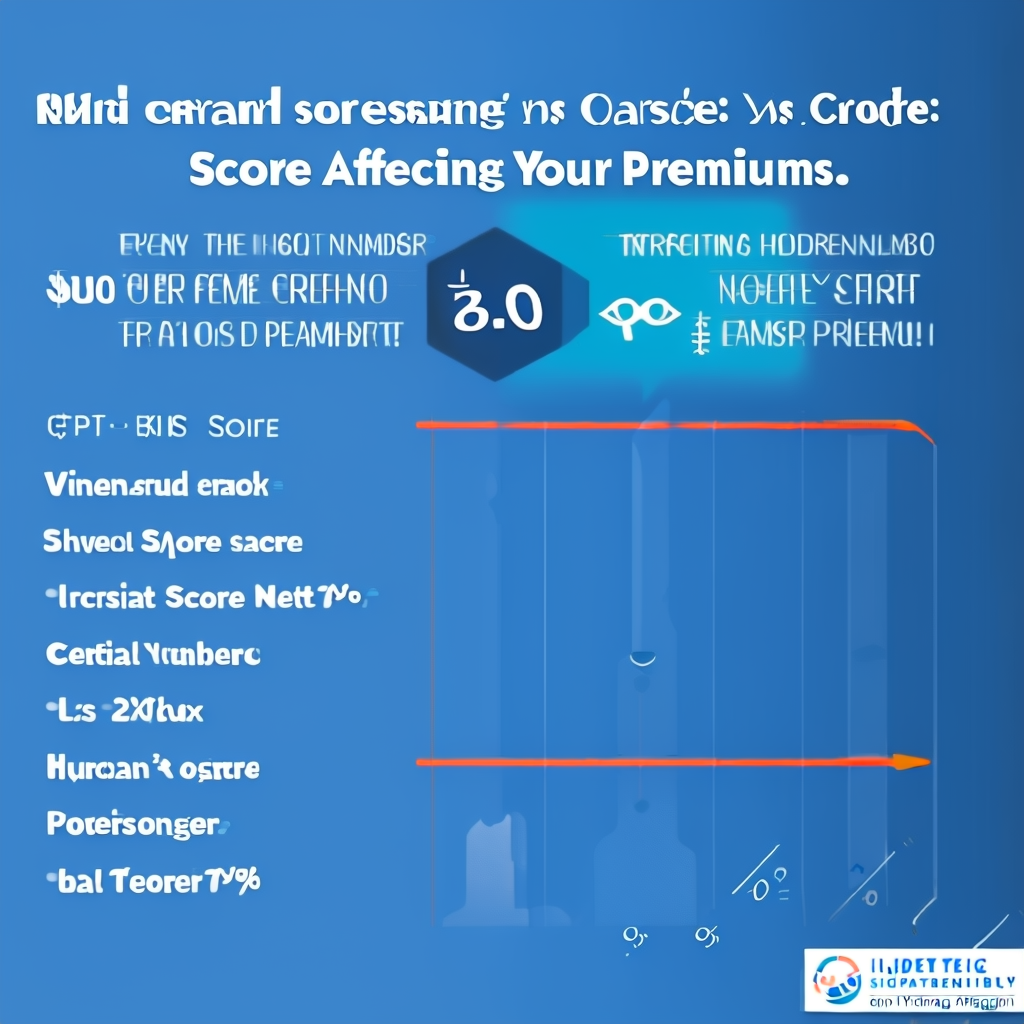Introduction
When it comes to managing your finances, two numbers often play a crucial role: your insurance score and your credit score. While many people are familiar with their credit score and its impact on loans and credit cards, the insurance score remains a hidden factor that can significantly affect your insurance premiums. Understanding the differences between these two scores and how they influence your insurance costs is essential for making informed financial decisions. In this blog post, we will delve into the intricacies of insurance scores and credit scores, exploring how they are calculated, their relationship, and what you can do to improve them.
What is an Insurance Score?
Definition of an Insurance Score and How It Differs from a Credit Score
An insurance score is a numerical representation of an individual’s risk profile as it pertains to insurance underwriting. It is a tool used by insurance companies to evaluate the likelihood that a policyholder will file a claim. While it may sound similar to a credit score, which assesses an individual’s creditworthiness and ability to repay debts, an insurance score is specifically tailored to predict insurance risk.
The primary distinction between the two scores lies in their focus and the data used to calculate them. A credit score is derived from an individual’s credit history, including payment history, outstanding debts, and credit utilization. In contrast, an insurance score incorporates various factors related to an individual’s behavior and history as an insurance policyholder, making it a more relevant metric for insurers when determining premiums and coverage eligibility.
Insurance scores are typically calculated using proprietary algorithms developed by insurance companies or third-party data providers. These algorithms analyze a range of factors to generate a score that reflects the individual’s risk level. Understanding the nuances of an insurance score is crucial for consumers, as it can significantly impact their insurance premiums and overall coverage options.
Explanation of the Factors That Contribute to an Insurance Score
Several key factors contribute to the calculation of an insurance score, each reflecting different aspects of an individual’s risk profile. Some of the most common factors include:
-
Claims History: One of the most significant components of an insurance score is the individual’s claims history. A history of frequent or high-cost claims can indicate a higher risk to insurers, leading to a lower insurance score. Conversely, a clean claims history, where the individual has not filed claims or has only filed minor claims, can positively impact the score.
-
Credit History: While an insurance score is not the same as a credit score, credit history plays a role in its calculation. Insurers often use credit-related data, such as payment history, outstanding debts, and credit utilization, to assess risk. Research has shown a correlation between credit behavior and insurance claims, leading many insurers to incorporate credit information into their scoring models.
-
Driving Record: For auto insurance, an individual’s driving record is a critical factor in determining their insurance score. Factors such as traffic violations, accidents, and the number of years of driving experience can influence the score. A clean driving record typically results in a higher insurance score, while a history of accidents or violations can lower it.
-
Demographic Information: Insurers may also consider demographic factors, such as age, gender, and location, when calculating an insurance score. Certain demographics may be associated with higher or lower risk levels, influencing the overall score.
-
Policyholder Behavior: Factors such as the length of time a policyholder has been with an insurer and their payment history can also contribute to the insurance score. Long-term customers with a history of timely payments may receive a more favorable score.
Overview of How Insurance Companies Use These Scores to Assess Risk
Insurance companies utilize insurance scores as a critical component of their underwriting process. By analyzing an individual’s insurance score, insurers can assess the level of risk associated with providing coverage to that individual. This assessment helps insurers determine appropriate premiums, coverage limits, and eligibility for specific policies.
When a consumer applies for insurance, the insurer will typically run an insurance score as part of the application process. A higher insurance score indicates a lower risk, which may result in lower premiums and more favorable coverage options. Conversely, a lower insurance score suggests a higher risk, leading to higher premiums or potential denial of coverage.
To underwriting, insurance scores can also play a role in ongoing policy management. Insurers may periodically review policyholders’ scores to assess changes in risk over time. If a policyholder’s score improves, they may be eligible for lower premiums or better coverage options upon renewal. Conversely, if a score declines, the insurer may adjust the policy terms or premiums accordingly.
An insurance score is a vital tool used by insurers to evaluate risk and determine premiums. By understanding the factors that contribute to an insurance score and how it differs from a credit score, consumers can take proactive steps to improve their scores and potentially lower their insurance costs. This knowledge empowers individuals to make informed decisions about their insurance needs and financial well-being.
What is a Credit Score?
Definition of a Credit Score and Its Purpose in Financial Transactions
A credit score is a numerical representation of an individual’s creditworthiness, reflecting their ability to repay borrowed money. Typically ranging from 300 to 850, this score is used by lenders, landlords, and other financial institutions to assess the risk associated with lending money or extending credit to an individual. The primary purpose of a credit score is to provide a quick and standardized way to evaluate a person’s financial behavior and reliability, helping lenders make informed decisions about whether to approve loans, credit cards, or rental applications.
Credit scores play a crucial role in various financial transactions. For instance, when applying for a mortgage, auto loan, or credit card, lenders will review the applicant’s credit score to determine the likelihood of timely repayment. A higher credit score generally indicates a lower risk, which can lead to more favorable loan terms, such as lower interest rates and higher credit limits. Conversely, a lower credit score may result in higher interest rates or even denial of credit, as lenders perceive a higher risk of default.
Understanding credit scores is essential for consumers, as they can significantly impact financial opportunities and overall financial health. By maintaining a good credit score, individuals can access better financial products and save money over time.
Breakdown of the Components That Make Up a Credit Score
Credit scores are calculated based on several key components, each contributing to the overall score. The most common components include:
-
Payment History (35%): This is the most significant factor in determining a credit score. It reflects whether an individual has made timely payments on their credit accounts, including credit cards, loans, and mortgages. Late payments, defaults, and bankruptcies can negatively impact this component, while a consistent history of on-time payments can enhance it.
-
Credit Utilization (30%): Credit utilization measures the amount of credit being used compared to the total available credit. It is calculated by dividing the total credit card balances by the total credit limits. A lower credit utilization ratio (generally below 30%) indicates responsible credit management and can positively influence the credit score. High utilization, on the other hand, can signal financial distress and may lower the score.
-
Length of Credit History (15%): This component considers how long an individual has been using credit. A longer credit history can positively impact the score, as it provides more data on the individual’s credit behavior. Factors such as the age of the oldest account, the age of the newest account, and the average age of all accounts are taken into account.
-
Types of Credit in Use (10%): This factor looks at the variety of credit accounts an individual has, including credit cards, installment loans, mortgages, and retail accounts. A diverse mix of credit types can be beneficial, as it demonstrates the ability to manage different forms of credit responsibly.
-
New Credit Inquiries (10%): This component reflects the number of recent credit inquiries made by lenders when an individual applies for new credit. While a few inquiries may not significantly impact the score, multiple inquiries within a short period can suggest financial distress and may lower the score.
Discussion of How Credit Scores Are Calculated and the Major Credit Bureaus Involved
Credit scores are calculated using algorithms developed by credit scoring models, with the most widely used model being the FICO score. The FICO score is utilized by many lenders to assess credit risk, but there are other scoring models, such as Vantage Score, which also play a role in the credit scoring landscape.
The major credit bureaus involved in the credit scoring process are Experian, TransUnion, and Equifax. These bureaus collect and maintain credit information on consumers, including payment history, credit accounts, and public records. When an individual applies for credit, lenders typically request a credit report from one or more of these bureaus to evaluate the applicant’s creditworthiness.
Each credit bureau may have slightly different information on a consumer, leading to variations in credit scores. This is why it’s essential for individuals to regularly check their credit reports from all three bureaus to ensure accuracy and address any discrepancies. Consumers are entitled to one free credit report per year from each bureau, which can be obtained through AnnualCreditReport.com.
A credit score is a vital tool used to assess an individual’s creditworthiness in financial transactions. By understanding the components that make up a credit score and how it is calculated, consumers can take proactive steps to improve their scores, ultimately leading to better financial opportunities and terms. Maintaining a good credit score is essential for achieving financial goals, whether it be securing a mortgage, obtaining a credit card, or renting a home.
How Insurance Scores Affect Your Premiums
Detailed Explanation of How Insurance Scores Influence the Cost of Premiums
Insurance scores play a crucial role in determining the cost of premiums for various types of insurance, including auto, home, and life insurance. Insurers use these scores to assess the risk associated with insuring an individual, which directly influences the premiums they charge. A higher insurance score typically indicates a lower risk, leading to lower premiums, while a lower insurance score suggests a higher risk, resulting in higher premiums.
When calculating premiums, insurance companies analyze the factors that contribute to an individual’s insurance score, such as claims history, credit history, driving record, and demographic information. By evaluating these factors, insurers can predict the likelihood of a policyholder filing a claim. For example, a policyholder with a clean claims history and a strong credit score is viewed as a lower risk, which may qualify them for significant discounts on their premiums. Conversely, an individual with a history of frequent claims or poor credit may face higher premiums due to the perceived risk of future claims.
Insurance companies often use tiered pricing models based on insurance scores. This means that individuals with higher scores may fall into a lower premium tier, while those with lower scores may be placed in a higher tier, resulting in a noticeable difference in premium costs. Understanding how insurance scores influence premiums is essential for consumers, as it empowers them to take steps to improve their scores and potentially lower their insurance costs.
Examples of How Different Insurance Scores Can Lead to Varying Premium Rates
To illustrate the impact of insurance scores on premium rates, consider the following examples:
-
High Insurance Score: A policyholder with an insurance score of 800 (on a scale of 300 to 850) may be eligible for a premium discount of 20% on their auto insurance. This individual has a clean driving record, no recent claims, and a strong credit history. As a result, their annual premium might be $800, but with the discount applied, it could drop to $640.
-
Average Insurance Score: A policyholder with an insurance score of 650 may fall into the average risk category. This individual has a few minor claims in their history and a moderate credit score. Their auto insurance premium might be set at $1,000. However, due to their average score, they may not qualify for any discounts, resulting in the full premium amount.
-
Low Insurance Score: A policyholder with an insurance score of 500 may be considered a high-risk individual. This person has a history of multiple claims, a poor credit score, and several traffic violations. As a result, their auto insurance premium could be significantly higher, perhaps around $1,500. This individual may also face challenges in finding coverage, as some insurers may refuse to provide policies to those with very low scores.
These examples highlight how varying insurance scores can lead to substantial differences in premium rates. By understanding this relationship, consumers can recognize the importance of maintaining a good insurance score to secure more favorable premium rates.
Discussion of the Potential for Savings by Improving Your Insurance Score
Improving an insurance score can lead to significant savings on insurance premiums. Since insurance scores are influenced by factors such as claims history, credit behavior, and driving record, individuals can take proactive steps to enhance their scores and, in turn, reduce their insurance costs.
-
Maintain a Clean Claims History: One of the most effective ways to improve an insurance score is to avoid filing unnecessary claims. Policyholders should consider paying for minor repairs out of pocket rather than filing a claim, as frequent claims can negatively impact their score. By maintaining a clean claims history, individuals can demonstrate to insurers that they are lower risk, potentially leading to lower premiums.
-
Improve Credit Health: Since credit history is a significant factor in determining insurance scores, individuals can work on improving their credit health. This can be achieved by paying bills on time, reducing outstanding debts, and keeping credit utilization low. As credit scores improve, insurance scores are likely to follow suit, resulting in lower premiums.
-
Review and Update Driving Records: For auto insurance, maintaining a clean driving record is essential. Policyholders should be mindful of their driving habits and avoid traffic violations. Taking defensive driving courses can also help improve driving records and may lead to discounts on premiums.
-
Regularly Review Insurance Policies: Consumers should periodically review their insurance policies and shop around for better rates. If an individual’s insurance score improves, they may qualify for lower premiums with their current insurer or find better rates with a different provider.
-
Utilize Discounts: Many insurers offer discounts for various reasons, such as bundling policies, being a long-term customer, or having safety features in vehicles. Policyholders should inquire about available discounts and take advantage of them to further reduce their premiums.
FAQs
Q: What is an insurance score?
A: An insurance score is a rating used by insurance companies to predict the likelihood of a policyholder filing a claim, based on their credit history and other factors.
Q: How does an insurance score differ from a credit score? A: An insurance score is specifically designed for evaluating risk in insurance underwriting, while a credit score assesses an individual’s creditworthiness for loans and credit.
Q: Why do insurance companies use credit scores?
A: Insurance companies use credit scores because studies show a correlation between credit history and the likelihood of filing claims, helping them determine premiums.
Q: Can I improve my insurance score?
A: Yes, you can improve your insurance score by managing your credit responsibly, such as paying bills on time, reducing debt, and avoiding new credit inquiries.
Q: How much can my insurance score affect my premiums?
A: Your insurance score can significantly impact your premiums, with some studies indicating that individuals with lower scores may pay up to 50% more for insurance.
Q: Are insurance scores regulated?
A: Yes, insurance scores are regulated, but the specific rules can vary by state, and consumers have the right to know how their scores are calculated and used.
Conclusion
Both insurance scores and credit scores are vital components of your financial profile, each influencing your insurance premiums in different ways. By understanding the nuances of these scores, you can take proactive steps to improve them, ultimately leading to lower insurance costs. Regularly monitoring your credit, maintaining a good claims history, and working closely with your insurer can help you achieve a better insurance score. As you navigate the complexities of insurance and finance, remember that a little knowledge can go a long way in securing the best rates and protecting your financial future.





